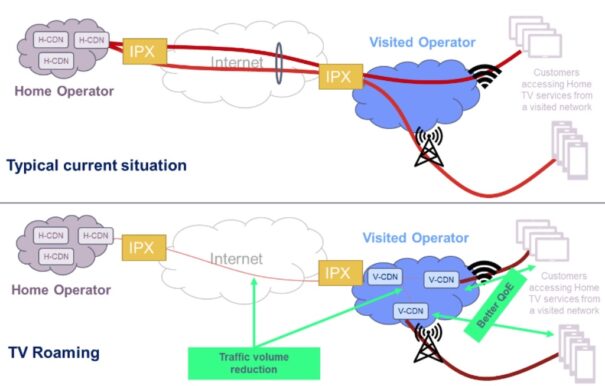Siminn, Broadpeak y Telefónica demuestran el potencial del concepto de “Tv Roaming”
Junto son Síminn, el mayor operador de telecomunicaciones de Islandia, Telefónica es una de las primeras compañías en demostrar la viabilidad y el interés de aplicar el concepto de “TV Roaming” a la distribución de los servicios de vídeo interconectando sobre Redes de Distribución de Contenidos (CDN) mediante el estándar Open Caching definido por la Streaming Video Technology Alliance (SVTA).
El deseo de ofrecer la mejor QoE a los usuarios de sus servicios de televisión y, al mismo tiempo, minimizar su impacto ha llevado a la mayoría de los operadores a desplegar sus propias CDN (Operator CDN) en sus redes.
Sin embargo, este enfoque tiene dos puntos débiles que limitan enormemente su potencial. Por un lado, cuando los abonados al servicio de televisión del operador se conectan a él desde fuera de su red, las CDN del operador dejan de ser la mejor alternativa para garantizar la mejor calidad y la mayor eficiencia, pues ya no son las más cercanas al usuario. La frecuencia de esta situación depende de los derechos sobre los contenidos de vídeo (por ejemplo, si están limitados a determinados países, ciudades…) y de la normativa, como en la UE, donde la normativa garantiza a los usuarios el acceso a sus servicios de vídeo desde cualquier país de la UE.
Por otra parte, no se diseñaron para gestionar cualquier tráfico de vídeo distribuido a través de la red del operador, sino, en general, sólo el tráfico relacionado con los propios servicios de vídeo del operador, dejando fuera la mayor parte del tráfico (por ejemplo, Netflix, DAZN, Google, Amazon, …). Este tráfico de terceros suele gestionarse a través de CDN de proveedores de contenidos o CDN comerciales (por ejemplo, Akamai, Cloudfront, Edgeio, …), ya sea con cachés desplegadas dentro o fuera de la red del operador.
Un nuevo concepto: TV Roaming
El concepto de TV Roaming es una propuesta para resolver la primera de las limitaciones anteriores y consiste en aplicar conceptos similares al conocido roaming en redes móviles. Cuando un usuario accede al servicio de TV desde la red de otro operador, es la CDN de este operador visitado quien entrega el contenido en nombre del Operador de origen y bajo su control.
De esta forma, es posible servir contenidos de vídeo desde la CDN del Operador más cercano al usuario, lo que permite ofrecer una mejor QoE y al mismo tiempo generar ahorros en ambos operadores, gracias a la reducción del tráfico de peering y a la entrega optimizada en la red del operador visitado.
La solución técnica para implantar TV Roaming se basa en el estándar Open Caching, definido por la Streaming Video Technology Alliance (SVTA), que gracias a sus API estándar permite a los proveedores de contenidos y a las CDN interconectarse entre sí.
En la prueba de concepto de TV Roaming llevada a cabo por Síminn y Telefónica, ambos operadores han interconectado sus respectivas CDN de operador utilizando el estándar Open Caching. En el caso de Siminn, su CDN está basada en la tecnología de Broadpeak, mientras que Telefónica ha utilizado su propia tecnología, denominada TCDN.
Las pruebas se han centrado en el escenario en el que un usuario de Siminn accede a su servicio de TV desde España a través de la red de Telefónica, y se delega en la Telefónica CDN (TCDN) para la entrega local en lugar de una entrega remota desde la CDN de Síminn en Islandia. Por ahora, las pruebas se han realizado en entornos de laboratorio, pero el objetivo es poder llevar la misma prueba de concepto a producción en los próximos meses.
La solución a la segunda limitación anterior es conseguir que sean las CDNs de los operadores las que entreguen todo el tráfico de vídeo que se consume a través de la red de cada operador, ya que son las únicas que pueden garantizar la mejor QoE del servicio y al mismo tiempo la mayor eficiencia de la red, gracias a su mayor capilaridad y proximidad al usuario final. En realidad, el escenario es el mismo que en el caso del Roaming de TV pero donde en lugar del Operador de Origen estamos hablando de un Proveedor de Contenidos o de una CDN Comercial. Por tanto, la solución técnica es la misma en ambos casos: Open Caching.
Gracias al escenario de TV Roaming, los Operadores tienen una gran oportunidad para poner en valor sus CDNs y contribuir a la consolidación de Open Caching como estándar industrial sin tener que esperar a los grandes proveedores de contenidos. Apostando por este escenario, los operadores podrán mejorar la calidad y eficiencia de sus servicios de TV, y al mismo tiempo evitar el principal obstáculo para la adopción masiva de Open Caching en la industria, su disponibilidad comercial.
Did you like this article?
Subscribe to our NEWSLETTER and you won't miss anything.



